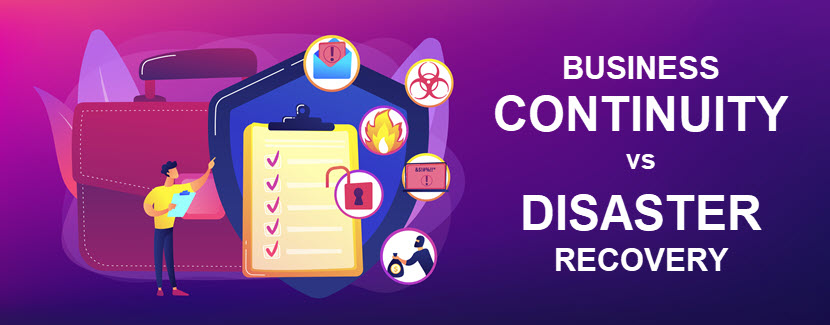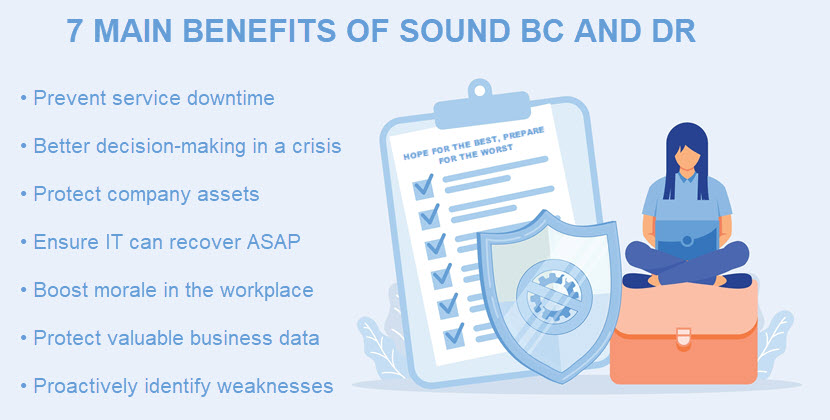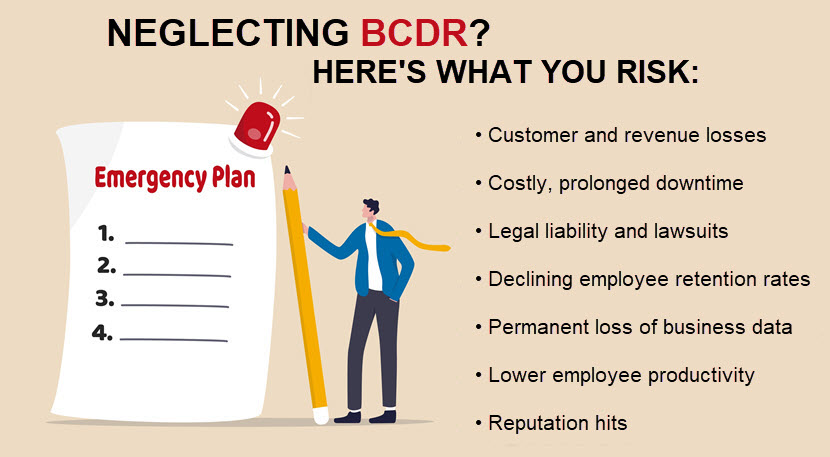Explain the Difference Between Business Continuity and Disaster Recovery Scolar
Despite some overlap, business continuity (BC) and disaster recovery (DR) play different roles in crisis management. A clear understanding of what sets these closely related fields apart (and how the two work in tandem) enables decision makers to create more effective plans for weathering business disruptions. This article explains the difference between business continuity and disaster recovery, two must-have strategies for any company wishing to avoid prolonged downtime. Read on to learn what company areas BC and DR protect, and see how combining both practices builds resiliency against potentially business-ending threats. Business continuity (BC) is a set of pre-defined plans that dictate how a company will continue to operate during a disruptive event. A BC plan temporarily addresses the incident to maintain critical business functions until the disruption is gone. The goal of BC is to minimize downtime in the event of an incident. For an enterprise, an average minute of service downtime costs $5,600. SMBs face fewer per-minute losses (somewhere in the $450 to $1000 range on average), but 29% of smaller businesses and startups never recover from a major disruption. Ideally, a company should prepare a BC plan for every possible disruption scenario. Incidents vary based on geography and industry verticals, but here are some of the most common ones: For example, a business continuity management plan for an office flood outlines the following course of action: Preparing a response plan for every scenario you can think of is not a business-smart approach. Most companies prepare plans only for realistic events (e.g., setting aside time and resources to prepare for a hurricane is not a priority for a California-based company). Disaster recovery (DR) is a set of pre-defined procedures that dictate how a company plans to recover its IT infrastructure after a disruptive event. Whereas BC aims to keep operations running during the incident, DR focuses on restoring technology-based systems to the pre-failure state. DR planning has three primary considerations: Disaster recovery is a subset of business continuity planning, and no BC strategy is complete without a plan for restoring IT functions. DR prepares for the same accidents as BC (natural disasters, cyber-attacks, insider threats, etc.) but focuses solely on restoring software and IT-related assets, such as: While a BC plan also covers these factors, business continuity goes deeper into how the company handles an incident (e.g., crisis management, employee safety, alternative office locations, PR strategies, etc.). These factors are not a part of DR planning. Let's look at the same flooding example to see how DR fits the BC picture. If a sudden burst of water hits your office, a DR plan helps quickly: Most DR strategies involve switching operations from the primary system to an alternative site. Instead of setting up expensive on-site backup systems, you can rely on disaster-recovery-as-a-service (DRaaS) and create a cloud-based infrastructure that instantly takes over operations in times of crisis. Both business continuity and disaster recovery are vital to company safety: Companies often combine business continuity and disaster recovery into a single initiative called BCDR. The growing popularity of BCDR shows that companies are increasingly realizing that different teams must collaborate when preparing for incidents instead of developing response plans in silos. While some organizations have the freedom to choose whether to invest in BCDR or not, some companies have legal obligations to prepare plans. Most businesses operating in financial, government, and healthcare industries must have some form of BC and DR readiness. Companies outline their BC and DR plans in two documents: Some businesses decide to use a single document for both plans. Let's take a closer look at what you must include in these plans regardless of whether you format them together or separately. Here's a list of everything you must include in a BCP: Here's a list of everything you need to cover in a DRP: The table below explains the main differences between business continuity and disaster recovery: Data backups and DR are another two closely related fields separated by a sometimes too blurry line. Our backup vs disaster recovery article explores the difference between the two practices and explains their unique roles in incident management. Some companies opt to perform BC and DR planning in silos, which is not a wise choice. Others focus on one and not the other, which is also a less-than-ideal way to plan for business disruptions. Business continuity and disaster recovery work best when you develop both practices in tandem and tackle unplanned events with both strategies. DR should be a subset of a broader business continuity plan, a part of the BCP that handles the "mitigate" and "recover" portions of the response procedure. A holistic approach to BCDR ensures you cover all business fronts in case of a disaster: The combined use of the two practices has the following benefits: No BCDR strategy is complete without reliable data backups. PhoenixNAP's backup and restore solutions enable you to use cloud-based backups and ensure no incident results in permanent data loss. Unfortunate events are bound to happen, and responding to them without proper BC and DR planning can be catastrophic. Incidents often cripple IT systems, prevent employees from working, and stop all revenue-generating operations. How long can your business tolerate such circumstances? Likely not very long, so start thinking about BCDR before an unplanned event severely damages your bottom line and reputation.
What Is Business Continuity?
What Is Disaster Recovery?
Why Are Business Continuity and Disaster Recovery Important?

Business Continuity Plan vs Disaster Recovery Plan
What Does a Business Continuity Plan Include?
What Does a Disaster Recovery Plan Include?
Business Continuity vs Disaster Recovery: Key Differences
Point of comparison Business continuity (BC) Disaster recovery (DR) Priorities Keep a business operational during a disaster and minimize service downtime Limit the impact of technology failures and restore the IT system as quickly as possible Scope Encompasses all business functions necessary to keep the organization running (including staffing, logistics, supplies, evacuation plans, etc.) Focuses only on one IT system and its data storage When it launches BC comes into effect as soon as decision makers learn about the incident DR is a post-incident response that starts after the initial phases of BC When it ends BC lasts until the business returns to normal operations, which is typically well after the disaster ends DR ends the moment IT infrastructure is back to its pre-incident state Inventory A BCP keeps inventory of all critical assets, including staff, suppliers, vehicles, buildings, etc. A DCP keeps an inventory of relevant IT assets and business data storage Risk analysis A BCP requires a macro-level business impact analysis of every threat that could realistically affect operations A DCP assesses only threats to the IT infrastructure and associated apps/services Proactivity BC emphasizes practices that minimize risk in equal measure as it focuses on response plans DR mainly focuses on reactive actions required to restore IT operations in case of an unfortunate event 
How Do Business Continuity and Disaster Recovery Work Together?
Business Continuity vs Disaster Recovery: Two Must-Have Practices for Any Security-Aware Company
Andreja Velimirovic
Andreja is a content specialist with over half a decade of experience in putting pen to digital paper. Fueled by a passion for cutting-edge IT, he found a home at phoenixNAP where he gets to dissect complex tech topics and break them down into practical, easy-to-digest articles.
Source: https://phoenixnap.com/blog/business-continuity-vs-disaster-recovery
0 Response to "Explain the Difference Between Business Continuity and Disaster Recovery Scolar"
Post a Comment